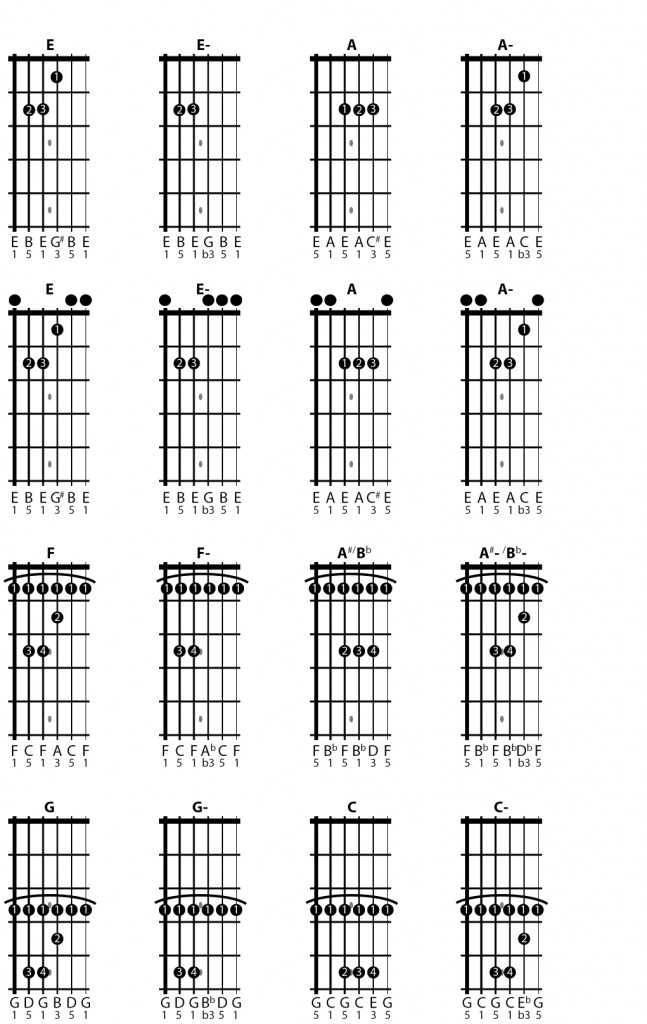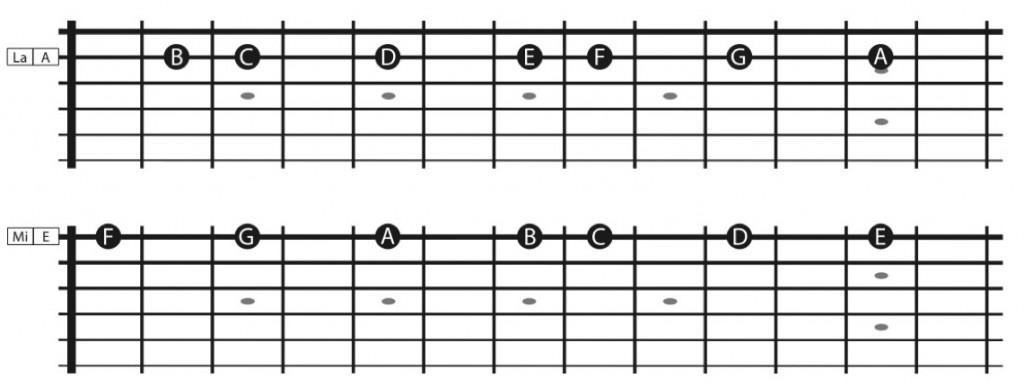The Complete Study of Bar Chords on Guitar.
You can find out more info about bar chords here:
To Fret or Not To Fret the Low E String on Bar Chords
In recap:
Bar chords are the E, E-, A and A- chord shapes that you move up and down the fretboard barring all 6 strings with your pointy finger behind the E, E-, A, and A- shapes.
In other words: you use your pointy finger like a capo. (Your index replaces the guitar nut behind the chord shapes.)
Or another way to look at it: you place your index on the black open string dots (as seen in the above graphic), and then move your index finger (as a bar that you place over all strings) along with the fingers on the strings that make up the E, E-, A, and A- shapes.
The following graphic shows how bar chords are E, Em, A, and Am shapes with a bar (pointy finger) placed behind the shapes.

Notice how they really are A and E shapes with your index barring all 6 strings right behind the shape.
Learn and Memorize The Locations of All The Chords.
More importantly: you want to learn where to find any bar chord on the guitar neck.
The following chart will be helpful in this.

This graphic shows where all the notes are on the low E and the low A string.
Ideally: you want to memorize these note locations.
So for example: let’s say that you want to figure out where the 2 F chords are (the F chord from an E shape and the F chord from the A shape).
When you look at the graphic, you see there is an F on the 1st fret of the E string. The F on the A string is on the 8th fret.
These are the 2 locations where I need to bar my index finger.
When barring on the 1st fret, where F is on the E string, you need to play the E shape with your remaining fingers.
When barring on the 8th fret: you would play the A shape there.
Both of these are F chords.
So in other words: when the root (the note that gives the chord its name) is on the E string, you need to play an E shape
When the root is on the A string, you need to play an A shape.
The reason why you would want to know this is that the more chords you know, the freer you are as a performer or writer.
Also: different versions of the same chord, all have a slightly different sound or texture.
You’re making your playing more sonically rich if you know how to play a chord in many different ways.
One more example: where are the 2 C bar chords?
Well, there is a C note on the 3rd fret of the A string. So I would have to place my bar on the 3rd fret and finger an A shape with my remaining fingers.
Again: when you play off of a root located on the A string, you need to play the A shape.
The other C note is on the 8th fret of the E string.
Bar on the 8th fret and finger an E shape with your remaining fingers, and that is a C chord right there.
Same for minor chords.
To find the 2 locations where the Dm chords are.
There is a D on the 5th fret of the A string. You would place your bar there on the 5th fret then finger an Am chord shape with your remaining fingers.
The other D is on the 10th fret of the E string. Place your bar on the 10th fret and finger an Em shape there.
For sharp ($) and flat (b) chords: you would use that above chart, and just move it down a fret for b and up a fret for #
# means white key of the piano up a fret
b means white key of the piano down a fret.
So for Dbm for example, you find the 2 Dm chord following the above guidelines, then move them down a fret to make them flat (b)
C# chords, are just the above 2 chords, moved up a fret.
Conclusion
If you know bar chords, you can literally play any song in any key.
This is important stuff. 🙂
The more chords you know, the more fun guitar gets.
Hit me up anytime at vreny@zotzinmusic.com if you have any questions, or if you would like to book a lesson.
These free lessons are cool, but you will never experience the progress, joy, and results that my students experience in lessons when you’re learning by yourself from blogs and videos.
That is why people take lessons: way better results and progress, much more complete information, exposed to way more creative ideas than you can get from a blog or YouTube video.
There is only so much that self-study can accomplish.
If you want to see amazing results and progress in your guitar playing, buy your first lesson here and get started ASAP.
You’ll impress your friends and loved ones in no time with your guitar playing!
Consider donating any small amount to help me keep this blog going.
Thank you for your support!



Bar Chord Training: David Bowie's Ashes To Ashes | ZOT Zin Guitar Lessons Says:
[…] Bar Chords […]
July 17th, 2020 at 8:27 am